The composting station was built on the Kizhi Island

Within the Kizhi Museum activities, a number of organic wastes are generated. The most problematic are kitchen wastes made by employees and contractors living in the Museum premises. To solve the problem, the Museum purchased and built some composters and installed them near residential buildings. However, due to different amounts of these wastes production, the composting process could not always be completely finished. So as to complete the composting process of the organic masses from composters and allow rotting a large amount of grass and leaves left from the Museum territory cleaning, the composting station was made and installed on the Kizhi Island.
The building inside is divided into 3 equal rooms by partition walls; each premise has a useful volume of 6 m3. There are numerous holes in the floor to remove the filtrate formed during composting. And it allows sufficient air amount to enter – this is necessary for the rapid biological process progress. The second floor with a slope and installed container was made to collect the filtrate.
It is planned to fill 1 or 2 rooms (if necessary) during the year, the 3rd room will be filled the next year. When the 3rd room is fully filled, the 1st premise will be cleaned, since the composting process there will be fully completed. Produced high-quality compost will be used as fertilizer in the exposition herb garden, flowerbeds and potato fields of the Museum.









